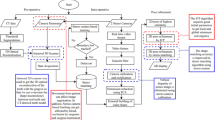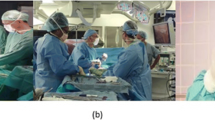Abstract
With the increasing demand for orthodontic treatment, the skill of wire bending is more and more important for orthodontists. Traditional wire bending training needs a high cost of time and resources. In this paper, an augmented reality assisted wire-bending training system (ARAWTS) is proposed. ARAWTS provides 4 typical wire bending training tasks for the trainee and can give training feedback and improvement advice to the trainee by gesture recognition during the training. For the elaborate and vague wire bending gesture recognition, we develop a temporal logical relation (TLR) module to sparsely sample dense frames and learn the TLRs between frames of gestures. To reduce the computational cost and time, we introduce a new type of sparse optical flow called Focus Grid Optical Flow (FGOF). From the results of experiments, the proposed algorithm implemented on an AR device (HoloLens) achieves a high recognition rate with low computational complexity and ARAWTS is proved reliable.










Similar content being viewed by others
References
Ballesté F, Torras C (2013) Effects of human–machine integration on the construction of identity. In: Luppicini R (ed) Handbook of research on technoself: identity in a technological society. IGI Global, pp 574–591
Baraldi L, Paci F, Serra G et al (2014) Gesture recognition in ego-centric videos using dense trajectories and hand segmentation. In: Proceedings of the IEEE conference on computer vision and pattern recognition workshops, 688–693
Carreira J, Zisserman A (2017) Quo vadis, action recognition? A new model and the kinetics dataset. In: Proceedings of the IEEE conference on computer vision and pattern recognition, pp 6299–6308
Cheng W, Sun Y, Li G et al (2019) Jointly network: a network based on CNN and RBM for gesture recognition. Neural Comput Appl 31(1):309–323
Dong J, Xia Z, Yan W et al (2019) Dynamic gesture recognition by directional pulse coupled neural networks for human-robot interaction in real time. J Vis Commun Image Represent 63:102583
Hilliges O, Kim D, Izadi S et al (2017) Grasping virtual objects in augmented reality: U.S. Patent 9,552,673. 2017-1-24.
Hughes CE, Stapleton CB, Hughes DE et al (2005) Mixed reality in education, entertainment, and training. IEEE Comput Graph Appl 25(6):24–30
Karpathy A, Toderici G, Shetty S et al (2014) Large-scale video classification with convolutional neural networks. In: Proceedings of the IEEE conference on computer vision and pattern recognition, pp 1725–1732
Kay W, Carreira J, Simonyan K et al (2017) The kinetics human action video dataset. arXiv:1705.06950
Kethman W (2021) Human–machine integration and the evolution of neuroprostheses. In: Atallah S (ed) Digital surgery. Springer, Cham, pp 275–284
Kim TK, Wong SF, Cipolla R (2007) Tensor canonical correlation analysis for action classification. In: 2007 IEEE conference on computer vision and pattern recognition. IEEE, pp 1–8
Kono H, Kikuchi M (2020) Analysis of orthodontic wire springback to simplify wire bending. Orthod Waves 79(1):57–63
Lau MN, Kamarudin Y, Zakaria NN et al (2021) Comparing flipped classroom and conventional live demonstration for teaching orthodontic wire-bending skill. PLoS ONE 16(7):e0254478
Lee SH, Cui J, Liu L et al (2021a) An evidence-based intelligent method for upper-limb motor assessment via a VR training system on stroke rehabilitation. IEEE Access 9:65871–65881
Lee SH, Yeh SC, Cui J et al (2021b) Motor indicators for the assessment of frozen shoulder rehabilitation via a virtual reality training system. Electronics 10(6):740
Lo YC, Chen GA, Liu YC et al (2021) Prototype of augmented reality technology for orthodontic bracket positioning: an in vivo study. Appl Sci 11(5):2315
Lucas BD, Kanade T (1981) An iterative image registration technique with an application to stereo vision, vol 81, pp 674–679
Mehta D, Sridhar S, Sotnychenko O et al (2017) Vnect: real-time 3d human pose estimation with a single RGB camera. ACM Trans Graph: TOG 36(4):1–14
Nyre-Yu MM (2019) Determining system requirements for human-machine integration in cyber security incident response. Purdue University Graduate School, West Lafayette
Osti F, de Amicis R, Sanchez CA et al (2021) A VR training system for learning and skills development for construction workers. Virtual Real 25(2):523–538
Rios H, Hincapié M, Caponio A et al (2011) Augmented reality: an advantageous option for complex training and maintenance operations in aeronautic related processes. In: International conference on virtual and mixed reality. Springer, Berlin, Heidelberg, pp 87–96
Rodriguez MD, Ahmed J, Shah M (2008) Action Mach a spatio-temporal maximum average correlation height filter for action recognition. In: 2008 IEEE conference on computer vision and pattern recognition. IEEE, pp 1–8
Sanin A, Sanderson C, Harandi MT et al (2013) Spatio-temporal covariance descriptors for action and gesture recognition. In: 2013 IEEE workshop on applications of computer vision (WACV). IEEE, pp 103–110
Simonyan K, Zisserman A (2014) Two-stream convolutional networks for action recognition in videos. arXiv:1406.2199
Sivarajan S, Soh EX, Zakaria NN et al (2021) The effect of live demonstration and flipped classroom with continuous formative assessment on dental students’ orthodontic wire-bending performance. BMC Med Educ 21(1):1–12
Soomro K, Zamir AR, Shah M (2012) UCF101: a dataset of 101 human actions classes from videos in the wild. arXiv:1212.0402
Tang YM, Ng GWY, Chia NH et al (2021) Application of virtual reality (VR) technology for medical practitioners in type and screen (T&S) training. J Comput Assist Learn 37(2):359–369
Tran D, Bourdev L, Fergus R et al (2015) Learning spatiotemporal features with 3d convolutional networks. In: Proceedings of the IEEE international conference on computer vision, pp 4489–4497
Vakaliuk TA, Pochtoviuk SI (2021) Analysis of tools for the development of augmented reality technologies. In: CEUR workshop proceedings
Wang J, Liu Z, Wu Y et al (2012) Mining actionlet ensemble for action recognition with depth cameras. In: 2012 IEEE conference on computer vision and pattern recognition. IEEE, pp 1290–1297
Wang L, Xiong Y, Wang Z et al (2016) Temporal segment networks: towards good practices for deep action recognition. In: European conference on computer vision. Springer, Cham, pp 20–36
Waters NE, Stephens CD, Houston WJB (1975) Physical characteristics of orthodontic wires and archwires—part 1. Br J Orthod 2(1):15–24
Wong SF, Kim TK, Cipolla R (2007) Learning motion categories using both semantic and structural information. In: 2007 IEEE conference on computer vision and pattern recognition. IEEE, pp 1–6
Wu XY (2020) A hand gesture recognition algorithm based on DC-CNN. Multimed Tools Appl 79(13):9193–9205
Wu Y, Zheng B, Zhao Y (2018) Dynamic gesture recognition based on LSTM-CNN. 2018 Chinese Automation Congress (CAC). IEEE, pp 2446–2450
Zhao Z, Elgammal AM (2008) Information theoretic key frame selection for action recognition. In: BMVC, pp 1–10
Zhou J (2021) Virtual reality sports auxiliary training system based on embedded system and computer technology. Microprocess Microsyst 82:103944
Zhu G, Zhang L, Shen P et al (2017) Multimodal gesture recognition using 3-D convolution and convolutional LSTM. IEEE Access 5:4517–4524
Acknowledgements
This study was funded by the National Natural Science Foundation of China (U2013205).
Author information
Authors and Affiliations
Corresponding author
Ethics declarations
Conflict of interest
The author declare that they have no conflict of interest.
Ethical statements
Ethical review and approval were waived for this study, due to the nature of data collected, which does not involve any personal information that could lead to the later identification of the individual participants.
Additional information
Publisher's Note
Springer Nature remains neutral with regard to jurisdictional claims in published maps and institutional affiliations.
Rights and permissions
About this article
Cite this article
Dong, J., Xia, Z., Zhao, Q. et al. Human–machine integration based augmented reality assisted wire-bending training system for orthodontics. Virtual Reality 27, 627–636 (2023). https://doi.org/10.1007/s10055-022-00675-x
Received:
Accepted:
Published:
Issue Date:
DOI: https://doi.org/10.1007/s10055-022-00675-x




